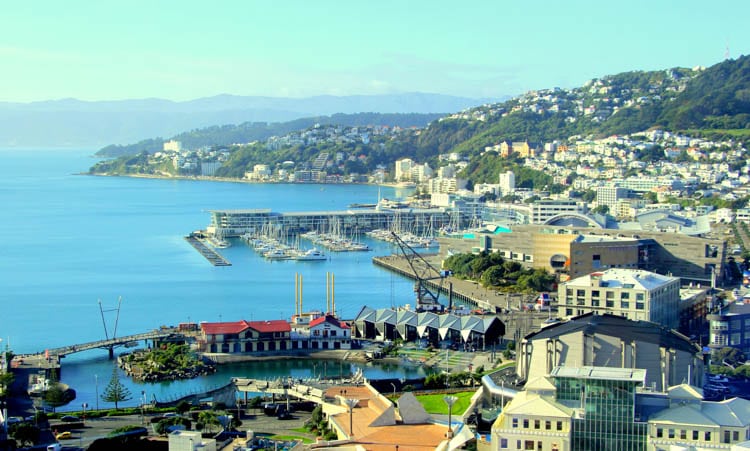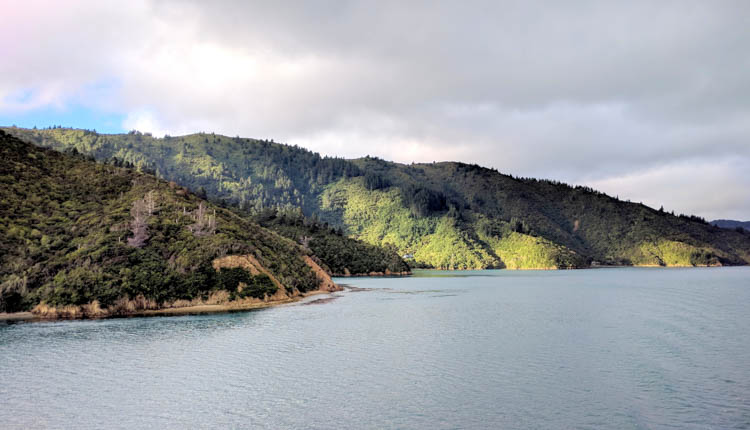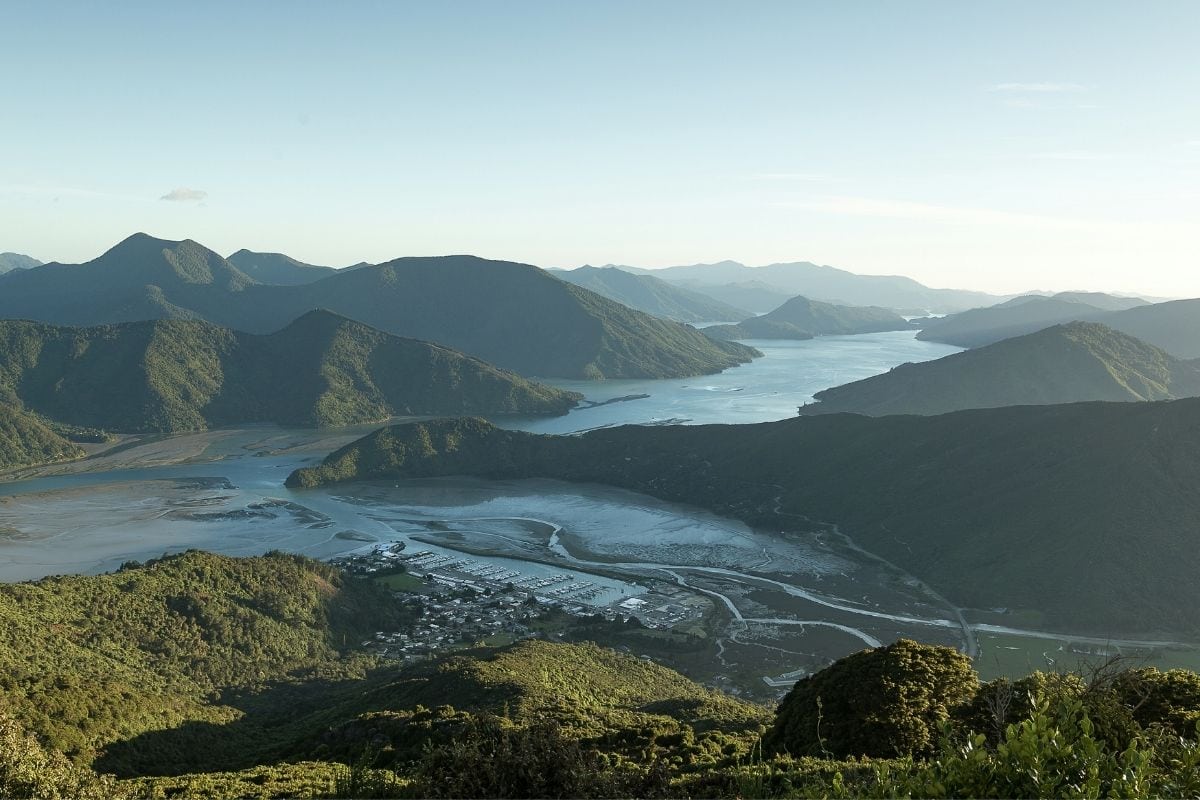
Go World Travel is reader-supported and may earn a commission from purchases made through links in this piece.
Windy. Incredibly, breathlessly, eye-wateringly windy.
If there was one word that could epitomise the journey onboard the Inter Islander NZ, it was ‘windy’. I was aboard the ferry services connecting Wellington to Picton, crossing over 90 km of the Cook Strait, and was being blown away, literally, by the roaring forties.

The Great Journey Begins
My journey started in Wellington – the small but gorgeous capital of New Zealand. Furthermore, it’s the southernmost capital city in the world and the windiest place on Earth (no, it’s not Chicago). The reason for the winds is its location right on the Cook Strait.
This narrow passage between the mountains of the North and South Islands of New Zealand channels the already tempestuous winds into a sort of violent wind tunnel. The result is 60 km ph winds for half the year in the windy capital.
Imagine then, the situation in the open waters of the strait. The winds having a field day, while I was fighting a dilemma to stay warm and cosy inside the vessel, or remain outside, face the chilling winds and admire the coastal beauty of this scenic country.
I could not help choosing the latter. After all, it was not every day that one embarked on one of the four Great Journeys of NZ.
The world-famous TranzAlpine train from Christchurch falls in this prestigious list. As does the aptly named Inter-Islander which connects North and South Island and is the only ferry-based journey on sea.

Braving the Elements on Deck of the Inter Islander NZ
I continued to stay on the topmost deck, as I watched the jade green hills of the North Island fade in the horizon. Tall windmills stood as sentinels on the hilltops, making excellent use of the abundant wind energy.
Meanwhile, sunlight poured in and out of thick clouds that floated above the landmass. It served as a reminder of the country’s Maori name, Aotearoa, the land of the long white cloud.
As the land retreated, all that remained were the choppy, teal-coloured waters of the strait, with the occasional shearwater soaring in the winds.
There was much promise of wildlife in this part – whales, dolphins, petrels, gannets, and gulls were apparently common sightings.
I, therefore, continued to brave the winds and while waiting for any sighting of the wild, reflected on the relatively young history of this beautiful country. The last one to be settled by man.

Who Discovered New Zealand?
The strait slicing New Zealand in half is named after Captain James Cook, the first European who passed through these waters in 1770.
More than a century earlier, Dutch Explorer Abel Tasman had, in 1642, come close but had mistaken the strait as a bight – a curved coastline. Thus naming it Zeehaen’s Bight, only to be corrected by Cook.
But Maori legends will talk of Kupe, the legendary Polynesian navigator who had discovered the strait about 800 years before.
He is also the one credited with the discovery of this country, who having sighted white clouds on the horizon deduced the presence of land, thereby giving the name Aotearoa. (You will chance upon his statue, celebrating this moment of discovery near the Wellington Harbour).

Comfort Found
The winds continued their fury. More clouds came in and blocked the sun as well, taking away the last source of warmth. I went inside seeking some shelter finally and warming my icy bones with a cup of coffee.
Children’s play area, restaurant, bar and movies – the ferry had it all, for the three-hour journey. It would be incredibly hard to leave these warm confines explaining why most travellers preferred to remain indoors.
I continued to savour my coffee while choosing a cosy corner, with glass windows still giving me the privilege of both worlds.
I was going through a few brochures and learnt a few more tidbits about the northern part of South Island where I was headed.
My destination, Picton was named after Sir Thomas Picton – a military associate of the Duke of Wellington.

Battle for Capital
Across the strait then, the two cities made quite a knighted pair. Together with nearby Nelson and Blenheim, Picton receives some of the highest sunshine in all the country.
This makes it a fantastic location to explore the beautiful Marlborough Sound region. While a bucolic and very peaceful region, the towns around the Cook Strait received a lot of political attention in the 1860s when the country was seeking a new capital.
Auckland in the far north was already bustling with immigrant activity, while Dunedin in the far south was overflowing with the riches of the Otago Gold Rush. And yet, the administration sought a neutral, more centrally located capital for the country.
The jewels of the Cook Strait – Wellington, Picton, Queen Charlotte Sound, Pelorus Sound, Blenheim, and Nelson – were all last-level contenders.
Finally, Wellington, the country’s first English settlement, got crowned and the honour of the capital remained with the North Island (after Okiato and Auckland).

Approaching Lush South Island
I glanced through my window and could see land – implying that we had entered the fringes of the South Island. I immediately dashed out to the deck and was overwhelmed with the beauty of the verdant hills dropping into the sea.
The sun had returned and with the hills flanking the last stretch of the journey, the wind had dropped significantly, suddenly making the cruise so much more enjoyable.
With so much rainfall, the hills looked lush and rich. Some were covered with pine trees in dark emerald. Meanwhile many more had been denuded to make way for lime-coloured grasslands to sustain the large sheep farms.
The domestication continued in the waters, strewn with oyster and salmon farms. Yet, human habitation seemed few and far between. A generous sprinkling of blonde beaches and sandy alcoves added more natural beauty to the waters.

Pelorus Jack
I failed to spot any dolphins for which the waters are famous. But as a fellow Interislander ferry passed by the logo of the company – that of a dolphin prancing on a wave, reminded me of perhaps the most famous dolphin personality ever in recorded history – Pelorus Jack.
A Risso’s dolphin, Pelorus Jack was famous for escorting ships in these waters of the Cook Strait in the late 19th century. Particularly around French Pass, a region notorious for its tidal currents.
The dolphin faithfully guided ships for over two decades and became a totem for good luck – if Pelorus was around, your ship wouldn’t sink.
While dolphins and whales were hunted for their blubber, Pelorus Jack became so popular that many say that the local council passed laws for its protection. This made it one of the world’s first marine animals to be protected by law.
While its veracity is often challenged, it still adds to the nation’s story of being perhaps one of the most forward-looking countries in the world.
It was when we were nearing Picton, that I overheard children shouting with joy. No, it was not Pelorus Jack, he disappeared in 1912 for good. But I had spotted a couple of New Zealand fur seals, lazing on a small island in the setting sun.

Love at First Sight
The ferry was finally reaching Picton – all around the water inlet were undulating verdant hills some submerged in the waters and forming islands in the Sound (drowned river valley).
Picton was a small but charming township. On display were a handful of houses and a beautiful palm-fringed waterfront, sprayed with colourful flowers like a Pointillist painting. It was nearly sunset, and the town seemed inviting with its lights and lamps gradually coming to life.
I didn’t have long here – just the evening and the dawn – before I would take the return ferry the next day and then a flight out of Wellington. But even in this short duration, I knew I would be impressed and inspired. And I was.

Exploring Charming Picton
I took a walk along the quaint waterside in the late evening. Enjoyed a refreshing hike on the hills nearby at dawn. And spotted a small flightless hen-sized bird, (mistaking it for a kiwi with great excitement, only to realise it was a weka). Plus, of course, finding more seals and albatrosses on the return journey the next day.
Much like the rest of this small but beautiful country, Picton like every pitstop was an enlightenment. A special page dog-eared in your diary that happily proclaimed, that good things came in small packages indeed.
I was glad to have covered one of the four Great Journeys of this exceedingly picturesque country, promising both the land and myself to come back for the other ones someday in the future.
Author Bio: Ayan is a consultant by profession and loves traveling, and has been to nearly 30 countries. He likes writing about his travel experiences besides scribbling poetry, short stories and essays. He is currently working on a collection of haiku, and has recently published a coffee table book on the coastal beauty of New South Wales. You can read more of my travels at http://www.vagabonds-trail.com/

